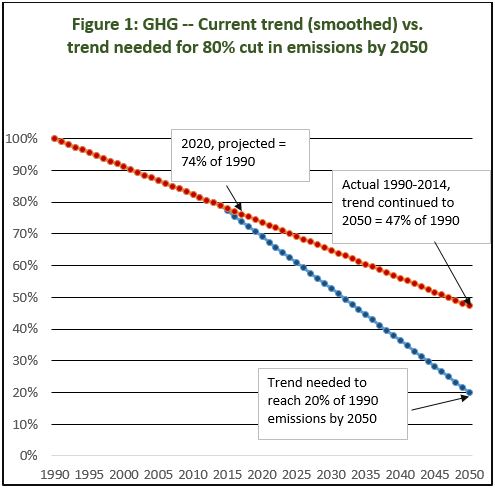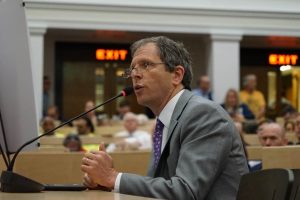By David W. Cash, Dean of the John W. McCormack School of Policy and Global Studies
On June 20, I had the honor to testify before the Massachusetts Legislature Joint Committee on Telecommunications, Utilities, and Energy in support of policies that would establish carbon pricing. Establishing a carbon fee will reduce greenhouse gas emissions and have many economic benefits — driving innovation, playing to Massachusetts’ strengths in technology development and entrepreneurship, creating economic equity, boosting clean energy economic development and providing the most cost-effective path to reach our mandated emissions targets.
You can listen to my testimony and read the full statement below.
Statement to the Joint Committee on Telecommunications, Utilities, and Energy, in support of bills S.1821 and H.1726 to institute carbon pollution pricing in Massachusetts
June 20, 2017
David W. Cash, PhD
Dean, John W. McCormack Graduate School of Policy and Global Studies
Sustainable Solutions Lab
University of Massachusetts Boston
Chairman Barrett, Chairman Golden, and members of the Committee:
Thank you for giving me the opportunity to speak today. I am the Dean of the McCormack Graduate School of Policy and Global Studies at UMass Boston, and one of the founders of the Sustainable Solutions Lab. During the administration of Governor Romney I served as Director of Air Policy, and in the administration of Governor Deval Patrick, I served as Undersecretary for Policy at the Executive Office of Energy and Environmental Affairs, as a Commissioner at the Department of Public Utilities, and as Commissioner of the Department of Environmental Protection.
In these later roles, I was deeply involved, with many of you, in the design of the Green Communities Act and the Global Warming Solutions Act, and worked to implement the Commonwealth’s comprehensive clean energy policies. I worked on the development and implementation of the Regional Greenhouse Gas Initiative–a market-based climate program and I was one of the architects of the Massachusetts Clean Energy and Climate Plan for 2020. In all of my positions, attaining emissions reductions while driving economic development and cost savings was a focus.
In the Commonwealth, we are a beacon to other states and even nations when it comes to our climate and clean energy policy. The list of accomplishments in solar, wind, storage, and energy efficiency is long and continuing. This legislature has been a global leader in this area and since 2007, we have gone from close to no wind and solar generation to over 100MW of wind and almost 1600 MW of solar; we are number one in the country in energy efficiency for five years in a row; we have saved consumers over $14B and reduced energy cost volatility; the clean energy sector in Massachusetts has about 6,000 firms, over 100,000 employees and is growing at about 10% per year; emissions from the electricity generating sector dropped by more than 40% while our gross state product increased by over 70%, putting a lie to the notion that environmental protection and economic development cannot go hand in hand. Just this morning, I gave the welcoming address to a remarkable collaboration of universities in New England (engineers, policy experts, economists, ecologists, oceanographers, etc.) focused on making sure Massachusetts and New England are the hub of the future offshore wind sector–a meeting that would not have happened had you not passed the energy diversity bill last summer. We exemplify bipartisan collaboration, cities and towns working with the state, and efficient and successful private/public partnerships. The result has been comprehensive climate change policy that drives economic benefits for all of our citizens.
With all this success, then, why am I here today? Because all of these achievements are not enough. Not enough to reach our statutory goals for emissions reductions, and not enough to seize the growing economic benefits of moving faster to the clean energy future.
I speak today in support of Senate Bill 1821 and House Bill 1726, and in support of carbon pollution pricing in general. Without such pricing, the state will not be able to reach the mandate of the Global Warming Solutions Act to reduce emissions 80% by 2050.
To understand this, and see why carbon pollution pricing is necessary it’s valuable to look at what has happened to the state’s emissions during the years since our baseline of 1990, and what is likely to happen in the future given our existing policies. Please review the figure that Senator Barrett presented earlier (Figure 1, below). Figure 1 shows that through 2014, the last year for which we have full data available, we have cut emissions by about 21 percent, so that they are now 79 percent of what they were in 1990. If the state continues to reduce emissions at the same rate shown by that trend line (red), by 2050 we will have cut emissions 53 percent, far from the 80% required. Thus the gap between the red line (projected emissions reductions with our current policies) and the blue line (required emissions reduction).

This gap makes clear why we need far more than our existing policies to reach the GWSA’s mandate. Our current policies have had the most success in reducing emissions from electricity generation, which have dropped by more than 40 percent, accounting for fully two-thirds of the overall reduction since 1990. This is a result of our most important policies being directed at this sector. They include the Renewable Portfolio Standard and our electric efficiency policies, the latter being the most aggressive in the country. In addition, the price of natural gas has dropped greatly, which has helped cause all the state’s coal-fired generating plants to shut down, greatly reducing emissions. As a result electricity now accounts for less than one-fifth of the state’s total emissions.
We have not, however, been nearly as successful in reducing emissions from the other two major sectors, transportation and heating of buildings, which between them now account for three and a half times the emissions from electricity. The state has well-funded programs to improve the efficiency of heating buildings, and also has a strict building code. Despite this, non-electricity emissions from buildings have only dropped 17 percent since 1990.
In transportation the situation is worse. The state has so far devoted only a few million dollars to induce people to move from gasoline-powered cars to electricity and other fuels, and its programs to shift people from cars to other means of transport have had only small results. As a result, emissions from transportation have dropped only 4 percent since 1990. We had expected that the Obama Administration’s new fuel efficiency standards for cars and trucks, extending out to 2025, would help us here, but those standards are now in danger. Given that transportation now accounts for two-fifths of our total emissions we must do better in this sector.
Given these dynamics, it will take new policy tools to shift these two sectors away from fossil fuels and into renewable energy – including providing the right market signals for consumers to purchase electric vehicles. Carbon pollution pricing can level the playing field for renewables, after over one hundred years of subsidies and government support for fossil fuels. While the Committee has before it a number of bills that would further clean up the electricity sector, there is nothing proposed other than carbon pricing that can substantially cut emissions from buildings and transportation, which together account for close to three quarters of the state’s emissions.[1]
Carbon pricing is the most comprehensive and cost-effective market-based policy available, and a policy that will impact emissions from all sectors of the economy, thus closing the gap seen in Figure 1. It has the potential to cut emissions more than any of the state’s existing policies or any other policy currently under consideration. And as proposed, revenue from the carbon fee would be returned to both residential and commercial consumers (sometimes called a carbon dividend).
Somewhat surprisingly, a coalition of conservative economists, past government officials and large companies is also pushing this idea, for its elegance, simplicity, and certainty. Just yesterday morning, in an op-ed piece in the Washington Post, Former Secretary of State George Shutlz and former Treasury Secretary Larry Summers wrote:
We are convinced that the carbon dividends approach …can strengthen the U.S. economy in ways highly valued by both the left and right and simultaneously spur global efforts to address climate change. Adopting a carbon dividend approach would pay huge dividends for the global climate, the U.S. economy and U.S. leadership in the world.[2]
Pricing carbon, and returning the revenues to citizens as rebates, will build on the clean energy foundation I mentioned earlier, drive innovation, play to Massachusetts’ strengths in technology development and entrepreneurship, create economic equity, boost economic development and provide the most cost-effective path to reach our mandated emissions targets in a way that is currently not possible.
I urge the Committee to expeditiously report out with a favorable recommendation one of these bills or a combination of the two.
[1] Marc Breslow calculations, based on DEP’s March 2017 Greenhouse Gas Inventory for the state. 32.9% of total emissions from buildings (residential, commercial, and industrial sectors), 39.4 percent from transportation, or 72.3 percent total.
[2] This is the one climate solution that’s best for the environment — and for business, George P. Shultz and Lawrence H. Summers, June 19, 2017, Washington Post. https://www.washingtonpost.com/opinions/this-is-the-one-climate-solution-thats-best-for-the-environment–and-for-business/2017/06/19/9736b72c-542f-11e7-a204-ad706461fa4f_story.html?utm_term=.3e09dbfcaa3a

